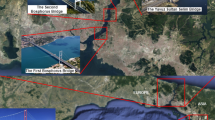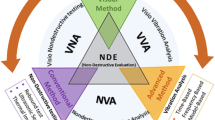Abstract
The perceptible vibration of concrete box girders under traffic loads is an important topic in existing bridges, on which vehicle movement often cause vibrations too strong from the viewpoints of travelers. In this paper, the results of an extensive program of full-scale ambient vibration tests involving a 380 m concrete box girder bridge, the Cannavino bridge in Italy, are presented. The human safety assessment procedure of the bridge includes ambient vibration testing, identification of modal parameters from ambient vibration data, comparison with a detailed finite element modeling as validation of experimental measurements, comparison of peak accelerations to reference values from technical standards/literature in order to estimate the vibration level, and evaluation of safety by the use of histograms. A total of nine modal frequencies are identified for the deck structure within the frequency range of 0–10 Hz. The results of the ambient vibration survey are compared to the modal frequencies computed by a detailed three-dimensional finite element model of the bridge, obtaining a very good agreement. It emerges that a linear finite element model appears to be capable of capturing the dynamic behavior of concrete box girder bridges with very good accuracy. For each direction, experimental peak accelerations are compared to acceptable human levels available in technical standards/literature, showing that traffic loads mainly induce a vertical component of vibration on the bridge deck. Finally, the elaboration of histograms allows to assess that the bridge is exposed to clearly perceptible vertical vibrations, requiring the adoption of suitable vibration reduction devices.












Similar content being viewed by others
References
Wilson JC, Liu T (1991) Ambient vibration measurements on a cable-stayed bridge. Earthq Eng Struct Dyn 20:723–747
Liu M, Frangopol DM, Kim S (2009) Bridge system performance assessment from structural health monitoring: a case study. J Struct Eng-ASCE 135(6):733–742
Ko JM, Ni YQ (2005) Technology developments in structural health monitoring of large-scale bridges. Eng Struct 27:1715–1725
Deraemaeker A, Reyndersb E, De Roeckb G, Kullaac J (2008) Vibration-based structural health monitoring using output-only measurements under changing environment. Mech Syst Signal Pr 22:34–56
Brownjohn JMW, Magalhaes F, Caetano E, Cunha A (2010) Ambient vibration re-testing and operational modal analysis of the Humber Bridge. Eng Struct 32:2003–2018
Moghimi H, Ronagh HR (2008) Development of a numerical model for bridge-vehicle interaction and human response to traffic-induced vibration. Eng Struct 30:3808–3819
Bosurgi G, Bongiorno N, Pellegrino O (2016) A nonlinear model to predict drivers’ track paths along a curve. Int J Civil Eng 14(5):271–280
Fiore A, Monaco P, Raffaele D (2012) Viscoelastic behaviour of non-homogeneous variable-section beams with postponed restraints. Comput Concrete 9(5):375–392
Fiore A, Foti D, Monaco P, Raffaele D, Uva G (2013) An approximate solution for the rheological behavior of non-homogeneous structures changing the structural system during the construction process. Eng Struct 46:631–642
Quaranta G, Fiore A, Marano GC (2014) Optimum design of prestressed concrete beams using constrained differential evolution algorithm. Struct Multidiscip Optim 49(3):441–453
Colapietro D, Fiore A, Netti A, Fatiguso F, Marano GC, De Fino M, Cascella D, Ancona A (2013) Dynamic identification and evaluation of the seismic safety of a masonry bell tower in the south of Italy. In COMPDYN 2013–4th ECCOMAS thematic conference on computational methods in structural dynamics and earthquake engineering, Kos Island, Greece, 12–14 June 2013
Magalhães F, Cunha Á (2011) Explaining operational modal analysis with data from an arch bridge. Mech Syst Signal Pr 25:1431–1450
Altunişik AC, Bayraktar A, Sevim B (2012) Operational modal analysis of a scaled bridge model using EFDD and SSI methods. Indian J Eng Mater Sci 19:320–330
Cury A, Cremona C, Dumoulin J (2012) Long-term monitoring of a PSC box girder bridge. Mech Syst Signal Pr 33:13–37
Bayraktar A, Altunişik AC, Türker T (2016) Structural condition assessment of Birecik highway bridge using operational modal analysis. Int J Civil Eng 14(1):35–46
Peeters B, De Roeck G (2001) Stochastic system identification for operational modal analysis: a review. J Dyn Syst Meas Control 123(4):659–667
Peeters B, De Roeck G (1999) Reference-based stochastic subspace identification for output-only modal analysis. Mech Syst Signal Pr 13(6):855–878
Van Overschee P, Moor BD (1996) Subspace Identification for Linear Systems. Kluwer Academic Publishers, Dordrecht
Fiore A, Monaco P (2009) POD-based representation of the alongwind Equivalent Static Force for long-span bridges. Wind Struct 12(3):239–257
Mallock HRA (1902) Vibrations produced by the working of traffic on the Central London Railway. Board of Trade Report, Command Papers
Smith JW (1988) Vibration of structures, application in civil engineering design. Chapman and Hall, Boca Raton
Bachmann H, Pretlove AJ, Rainer H (1995) Human response to vibrations. In Vibration problems in structures: practical guidelines. Birkhäuser Verlag, Basel
European Committee for Standardization (2002) Eurocode 2002. Basis of Structural Design—prAnnex A2. EN1990. European Committee for Standardization, Brussels
International Standards ISO 2631/2-1989 (E) (1989) International organization for standards. Evaluation of human exposure to whole-body vibration—part 2: continuous and shock induced vibration in buildings (1–80 Hz). International Standards ISO 2631/2-1989 (E), Geneva
Ministerio de Fomento Direcció n General de Carreteras (1999) Recomendaciones para la realización de pruebas de carga de recepción én puentes de carretera
Acknowledgements
This work is framed within the research project “DPC/ReLUIS, RS 4 - Osservatorio sismico delle strutture & monitoraggio” and within the COST Action “Quality Specifications for Roadway Bridges, Standardization at a European Level”, Action number TU1406.
Author information
Authors and Affiliations
Corresponding author
Rights and permissions
About this article
Cite this article
Fiore, A., Marano, G.C. Serviceability Performance Analysis of Concrete Box Girder Bridges Under Traffic-Induced Vibrations by Structural Health Monitoring: A Case Study. Int J Civ Eng 16, 553–565 (2018). https://doi.org/10.1007/s40999-017-0161-3
Received:
Revised:
Accepted:
Published:
Issue Date:
DOI: https://doi.org/10.1007/s40999-017-0161-3




